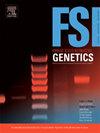霰弹枪宏基因组学的法医见解:追踪性交过程中的微生物交换。
IF 3.1
2区 医学
Q2 GENETICS & HEREDITY
引用次数: 0
摘要
微生物组正在成为法医科学中一个新兴的领域,具有很高的个性化潜力;然而,人们对生殖区域特有的细菌种类或它们在性接触中在个体之间传播的能力知之甚少。在这项概念验证研究中,我们通过收集7对一夫一妻制异性伴侣性交前和性交后的生殖器区域样本,包括阴茎、阴道和阴唇部位,研究了微生物转移动力学。利用霰弹枪宏基因组测序,我们对这些样品的微生物谱进行了测序。我们的研究结果揭示了从阴道微生物组到阴茎微生物组的显著转移,主要来自阴唇生殖器。此外,菌株分析揭示了同一种细菌在个体之间的明显差异,强调了微生物法医区分个体的潜力。这项研究有助于我们了解性接触过程中的微生物转移,并强调了生殖器微生物组的法医意义。本文章由计算机程序翻译,如有差异,请以英文原文为准。
Forensic insights from shotgun metagenomics: Tracing microbial exchange during sexual intercourse
The microbiome is becoming an emerging field of interest within forensic science with high potential for individualization; however, little is known about bacterial species specific to the genital area or their ability to transfer between individuals during sexual contact. In this proof-of-concept study, we investigated microbial transfer dynamics in seven monogamous, heterosexual couples by collecting pre- and post-sexual intercourse samples from their genital areas, including penile, vaginal, and labial locations. Utilizing Shotgun Metagenomic Sequencing, we sequenced the microbial profiles of these samples. Our findings reveal significant transfer from the vaginal microbiome onto the penile microbiome, predominantly originating from the labial genitalia. Moreover, strain analysis unveiled distinct differentiation between the same species of bacteria across individuals, underscoring the potential for microbial forensics to distinguish individuals. This study contributes to our understanding of microbial transfer during sexual contact and highlights the forensic implications of the genital microbiome.
求助全文
通过发布文献求助,成功后即可免费获取论文全文。
去求助
来源期刊
CiteScore
7.50
自引率
32.30%
发文量
132
审稿时长
11.3 weeks
期刊介绍:
Forensic Science International: Genetics is the premier journal in the field of Forensic Genetics. This branch of Forensic Science can be defined as the application of genetics to human and non-human material (in the sense of a science with the purpose of studying inherited characteristics for the analysis of inter- and intra-specific variations in populations) for the resolution of legal conflicts.
The scope of the journal includes:
Forensic applications of human polymorphism.
Testing of paternity and other family relationships, immigration cases, typing of biological stains and tissues from criminal casework, identification of human remains by DNA testing methodologies.
Description of human polymorphisms of forensic interest, with special interest in DNA polymorphisms.
Autosomal DNA polymorphisms, mini- and microsatellites (or short tandem repeats, STRs), single nucleotide polymorphisms (SNPs), X and Y chromosome polymorphisms, mtDNA polymorphisms, and any other type of DNA variation with potential forensic applications.
Non-human DNA polymorphisms for crime scene investigation.
Population genetics of human polymorphisms of forensic interest.
Population data, especially from DNA polymorphisms of interest for the solution of forensic problems.
DNA typing methodologies and strategies.
Biostatistical methods in forensic genetics.
Evaluation of DNA evidence in forensic problems (such as paternity or immigration cases, criminal casework, identification), classical and new statistical approaches.
Standards in forensic genetics.
Recommendations of regulatory bodies concerning methods, markers, interpretation or strategies or proposals for procedural or technical standards.
Quality control.
Quality control and quality assurance strategies, proficiency testing for DNA typing methodologies.
Criminal DNA databases.
Technical, legal and statistical issues.
General ethical and legal issues related to forensic genetics.

 求助内容:
求助内容: 应助结果提醒方式:
应助结果提醒方式:


